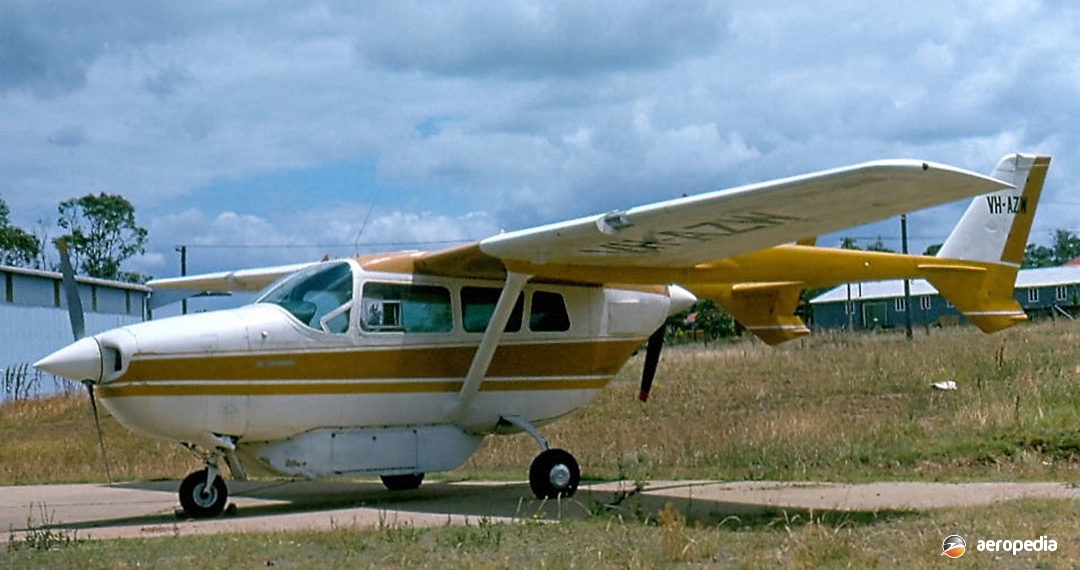Photograph:
Cessna 337 Super Skymaster VH-AZW (337-0115) at Bankstown, NSW in January 1977 (David C Eyre)
Country of origin:
United States of America
Description:
Light twin-engine cabin monoplane
Power Plant:
Two 157 kw (210 hp) Continental IO-360-CD six-cylinder horizontally-opposed air-cooled engines
Specifications:
- Wingspan: 11.58 m (38 ft)
- Length: 9.07 m (29 ft 9 in)
- Height: 2.85 m (9 ft 4 in)
- Wing area: 18.67 m² (201 sq ft)
- Max speed at sea level: 322 km/h (200 mph)
- Cruising speed at 75% power at 1,676 m (5,500 ft): 309 km/h (192 mph)
- Stalling speed flaps down, power off: 101 km/h (63 mph)
- Initial rate of climb: 396 m/min (1,300 ft/min)
- Service ceiling: 6,248 m (20,500 ft)
- Max range at 227 km/h (141 mph) at 3,048 m (10,000 ft): 2,237 km (1,390 miles)
- Fuel capacity: 351 litres (77 Imp gals)
- Optional fuel capacity: 495 litres (109 Imp gals)
- Take-off run: 248 m (805 ft)
- Landing run: 177 m (575 ft)
- Empty weight: 1,191 kg (2,625 lb)
- Loaded weight: 1,905 kg (4,200 lb)
History:
The Cessna Model 337 Super Skymaster series was introduced to the Company’s range in February 1965 to replace the Model 336 on the production line. It continued the centre-line thrust concept of the previous model, and bore a close resemblance to that aircraft. A number of major changes were introduced to enable the aircraft to compete with conventional twins of similar size and power.
In addition to more powerful engines, and a fully retractable tricycle undercarriage, the Model 337 had an increased wing incidence angle, improved forward visibility resulting from re-location of the forward engine, a re-designed cowling, a fixed dorsal air intake for cooling the rear engine, variable cowl flaps, increased tail-boom angle, and a wider chord elevator. Engines were the 157 kw (210 hp) Continental IO-360-C and IO-360-D six-cylinder fuel-injected units driving constant-speed, fully-feathering propellers.
Eventually the appellation Super Skymaster was changed to just Skymaster. This model proved to be more successful than the Model 336, and production of the 337 series comprised 1,859 Model 337s, 332 pressurised 337s, and 513 Model 337s for military operators. In addition Reims Aviation in France built 67 standard 337s and 27 pressurised aircraft. At least one was fitted with Pee Kay amphibious floats in the USA. A few variants were developed to meet customer demand and, in addition to the standard aircraft, the Turbo-System Super Skymaster with turbocharged engines had the ability to be flown at higher altitudes and from higher airstrips.
The Cessna 337 Turbo-System Super Skymaster model was only in production for a short period when it was superseded by the Model 337 Pressurised Skymaster, the prototype of which first flew on 23 July 1971. This was advertised as the cheapest twin-engine pressurised aircraft available at that time and differed from other Model 337s by having a pressure shell between the two engine firewalls, this resulting in different windows, the large windows giving way to eight smaller windows, four on each side. Cabin pressurisation was provided by exhaust driven engine turbo-superchargers. Engines were two 168 kw (225 hp) Teledyne Continental TSIO-360 six-cylinder, turbocharged fuel-injected units. Max speed was 402 km/h (250 mph) at 6,096 m (20,000 ft).
In 1975 and 1976 two new models were added to the range. Fully equipped IFR models, the Skymaster II and the Pressurised Skymaster II, incorporated as standard equipment an extensive package of avionics and accessories. In 1976 flap extension speeds were reduced, and aerodynamics and sound-proofing were improved.
In 1977 a new model was fitted with a Bendix weather radar mounted in a fibreglass pod that was attached to the front and rear spars below the right wing. This pod was located just outboard of the strut and did not alter flight characteristics.
As with other Cessna models, Reims Aviation in France produced the Model 337 under licence. In addition, it was delivered to the US Air Force as the O-2A forward air control and observation post, and the O-2B psychological warfare aircraft, which had loudspeakers and facilities for dropping leaflets.
One interesting Australian Cessna 337G was VH-MGW (c/n 33701502) of Adventure Bound Pty Ltd, which was used in the filming of six one-hour television documentaries on the tourist delights of New Zealand, this project being carried out in conjunction with Air New Zealand and Horizon Tours. It was a Robertson STOL-equipped aircraft with under-wing camera racks for aerial filming.
One Model 337 and one Model 337A have been registered in New Zealand, and some 44 examples have been registered in Australia.

